Our 2019 Nissan Altima Makes an Early Exit
32,852-Mile Wrap-Up
This long-term test wrap-up will not be like others we've done. That's because our 2019 Nissan Altima Platinum did not reach 40,000 miles, the standard end point for these extended-mileage reviews. Nissan called it home with 32,852 miles on its odometer.
Normally, we aim to accumulate the 40,000 miles required for completing our long-term tests within a year. But though we had the Altima for 17 months, shelter-at-home orders, work-from-home health-safety protocols, and who-wants-to-take-long-trips-anyway concerns kept it close to home for much of its stay. And 17 months is a long time for a car company's communications department to have an open budget item of $34,870 on the books. So, nice knowing you, Altima.
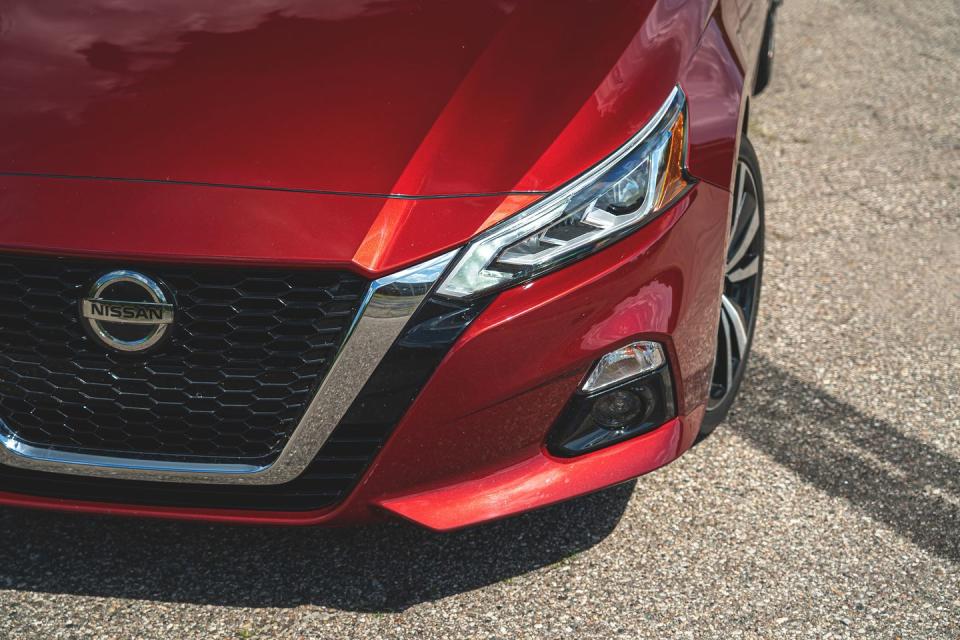
To be sure, it wasn't just COVID-19 that caused the Altima to languish; other C/D long-termers are making it to their official finish lines, if barely. It's also because the Altima simply didn't stir up the type of enthusiasm that had staffers clamoring to take it on long drives—even before the pandemic hit.
As we've reported, the Altima is more than competent as a family sedan and has several strong attributes. It looks sharp, it handles adroitly, and it's both spacious and comfortable. And, in our test car's top-spec Platinum trim, it's decently appointed. But we didn't do it any favors by configuring it with all-wheel drive, which can only be paired with the base 182-hp 2.5-liter inline-four and a continuously variable automatic transmission (CVT). It's a powertrain that feels not only lethargic but also considerably lazier than its zero-to-60-mph time of 7.6 seconds would suggest. What's more, the engine sounds labored when you press it for even moderate acceleration. Its performance and behavior would probably be fine for the average family-sedan customer, but that's not us.
A car that's otherwise this pleasant to drive would have been better served by Nissan's optional 248-hp 2.0-liter VC Turbo, the world's first variable-compression production engine. While our experience with that inline four-cylinder in our long-term Infiniti QX50 SUV made us think it needed more engineering development—it suffered from annoying surging during acceleration—we'd still recommend it over the base engine we saddled our Altima with. And as for the all-wheel-drive system, which we wanted to try out during our snowy Michigan winter, it worked seamlessly and was aided by a set of Nokian Hakkapeliitta R3 winter tires ($1285 for four). Our advice: Skip the all-wheel-drive setup. We firmly believe that a front-drive sedan like the Altima outfitted with winter tires is all you need in the snowy months if you live almost anywhere south of Nome, Alaska.
While we're on the subject of far-off places, our Altima did manage to visit a few. Over the course of those 17 months, the Altima went as far away as Wisconsin, visited Chicago, and made a run to Michigan's Mackinaw City, the berg at the foot of the bridge that connects Michigan's lower peninsula to its upper peninsula—the U.P., as we Michiganders call it. Since our 30,000-mile update, we drove it another 2593 miles before handing it back to Nissan. Staff editor Annie White put on the largest chunk of those miles, road-tripping all the way up to the U.P. and back, about 350 miles each way.
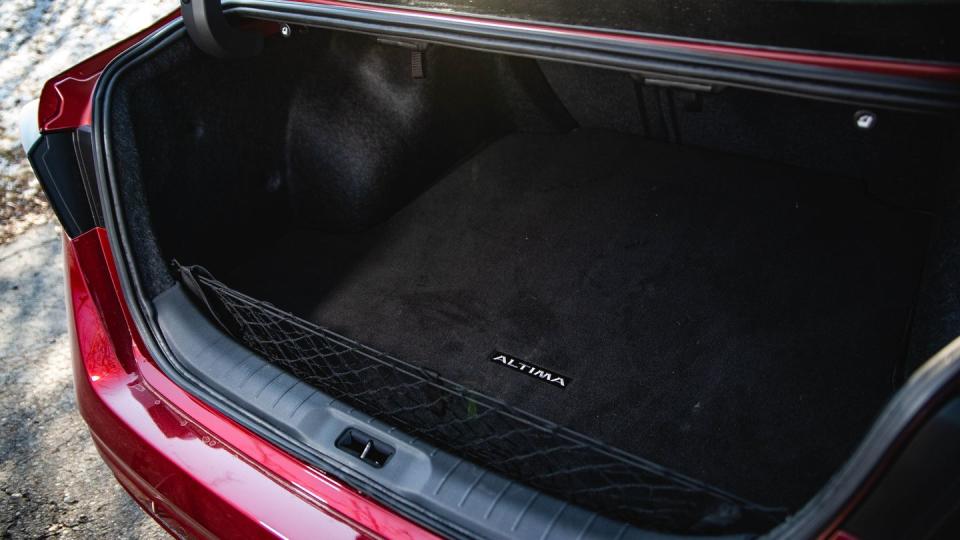
On those longer trips we found that the Altima comfortably ate up highway miles and coddled its driver and front passenger in the kind of plush-yet-supportive seats you'd expect to find in a more expensive car. Highway miles gave us the opportunity to experience its driver-assist systems, wherein we decided that Nissan's Intelligent Lane Intervention isn't as bright as its name suggests. Designed to help the driver keep the car centered in the lane when the cruise control is on, the system jerks the Altima obnoxiously away from any lane marker that the car strays close to. Many other similar systems intervene with far more finesse. It didn't take us long to shut it off. We were also surprised on multiple occasions when the automated braking system jammed on the brakes without warning as we were backing slowly into parking spots in the C/D lot. It apparently mistook the approaching curb for an object or a person.
Mostly, the Altima did local duty, unobtrusively ferrying staffers, friends, family members, and pets around the greater Detroit area with a distinct lack of either drama or behind-the-wheel fun. We'll concede that most family-car buyers aren't looking for a car with an engaging personality—or any personality, for that matter—but everyone wants reliability and low running costs. Here the Altima proved strong.

When it rolled into our fleet we were eager to compare it to the 10Best-winning 2018 Honda Accord that was wrapping up its long-term test. While it's clear that the Altima doesn't possess the Accord's sharp driving chops, it was more than the Honda's equal in its terms of operating costs. Over the 32,860 miles we had it, the Altima made no unscheduled stops at the dealer for unexpected repairs. Basic maintenance, which included oil and filter changes, brake-fluid replacement, a new cabin air filter, and an infotainment-screen update, totaled $462.
Over the same roughly 30,000-mile span, the Accord required some $514 in scheduled maintenance. Advantage, Altima. However, the Altima Platinum runs low-profile 235/40R-19 Hankook Kinergy GT all-season tires. Their thin sidewalls didn't stand up well to Michigan's hungry potholes. We damaged two tires, which cost us an additional $364 to replace. Both the Honda and Nissan also suffered stone-chipped windshields that required around a thousand bucks to replace. And on one trip to Michigan's Sleeping Bear Dunes National Lakeshore, the Altima had a coming together with a deer, which didn't cause much obvious damage but still cost $4479 to put right.
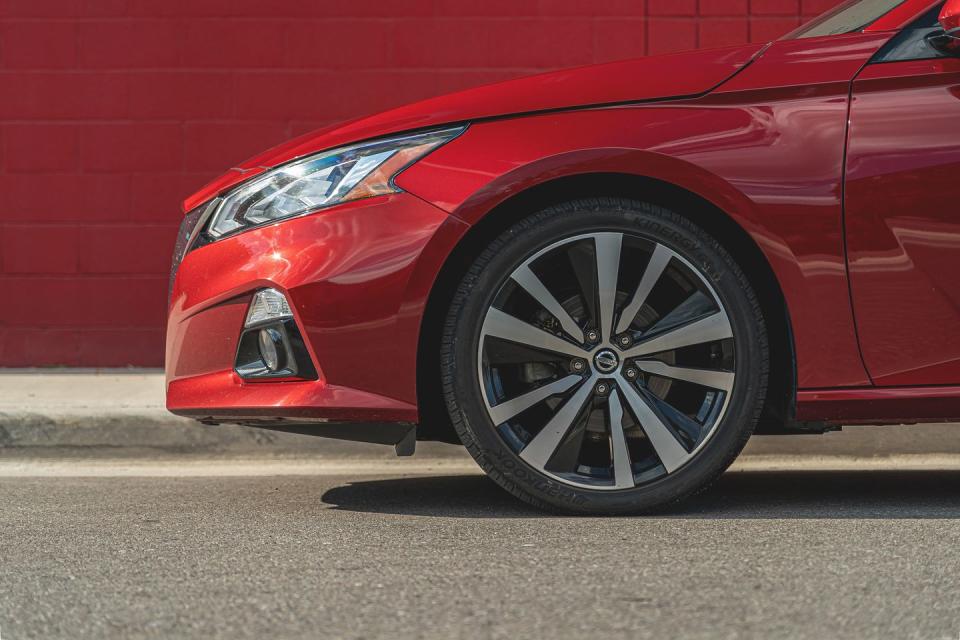
Those extra-cost repairs are broken out under our "damage and destruction" heading. However, we couldn't project expected brake-pad or tire life as we normally do at the 40,000-mile mark. That's when we take the measurements from which we extrapolate wear expectancies. (It's also where we conduct our final performance testing, which also was not done due to the Altima's early exit.) The only issue with the Altima that we weren't able to address before it disappeared was its wonky audio-system volume knob, which would have been handled under warranty at no cost.
With so few miles since our last installment, there's little more to tell about our Altima experience. In the short period of time following its 30,000-mile update, no new data emerged and no staff feelings about it shifted. Annie White, upon returning from her foray to Michigan's northernmost region, summed up our opinion of the Altima with the logbook's final comment: "It served me fairly well on this and other trips, but I can't say that I'll miss it."
Months in Fleet: 16 Current Mileage: 32,860
Average Fuel Economy: 28 mpg
Fuel Tank Size: 16.0 gal Observed fuel range: 448
Service: $462 Normal Wear: $0 Repair: $0
Damage and Destruction: $6076
30,000-Mile Update

Neutrality may be a good thing for global and office politics, but having no enemies doesn't mean you've made many friends. Such is the case with our Nissan Altima. Nissan introduced the latest version of its popular family sedan in 2019, and early drives had us thinking it might be a strong competitor to the seemingly unbeatable 10Best-winning Honda Accord. So, we inducted an Altima into our long-term fleet for a 40,000-mile test. But as we racked up miles, our thoughts have become dominated by utter indifference.
Stay-at-home orders have drastically curtailed our driving, so the Altima has accumulated mileage slowly over the past few months. During one six-week period, it covered only about 350 miles, roughly 85 percent less than it would have in normal use. But while it has taken longer than usual to reach the 30,000-mile mark, the extra time we've had with it has done nothing to change the meh feeling it inspires.

In the logbook, editor-in-chief Sharon Carty spoke for all of us [Of course she did, Ceppos. She's the boss—Ed.] when she wrote: "I've had the Altima for the bulk of our shelter-in-place order. After living with it for a month, I'm 100 percent neutral on this car. I don't feel like I got stuck with a dud, but I'm also not excited to get into it every day."
As we've noted before, a major contributor to our feelings about the Altima has to do with its powertrain. We ordered a top-spec Platinum model with the optional all-wheel-drive system, which can be had only with the base 182-hp 2.5-liter inline-four and a continuously variable automatic transmission (CVT). As assistant technical editor Maxwell B. Mortimer noted, "the CVT is clumsy and lethargic and, coupled with the grumbly four-cylinder engine, makes for a noisy and slow experience anytime you ask for meaningful acceleration." We would advise anyone interested in purchasing an Altima to forget about the base engine and instead opt for the 248-hp turbocharged 2.0-liter four-cylinder, which is paired exclusively with front-wheel drive.
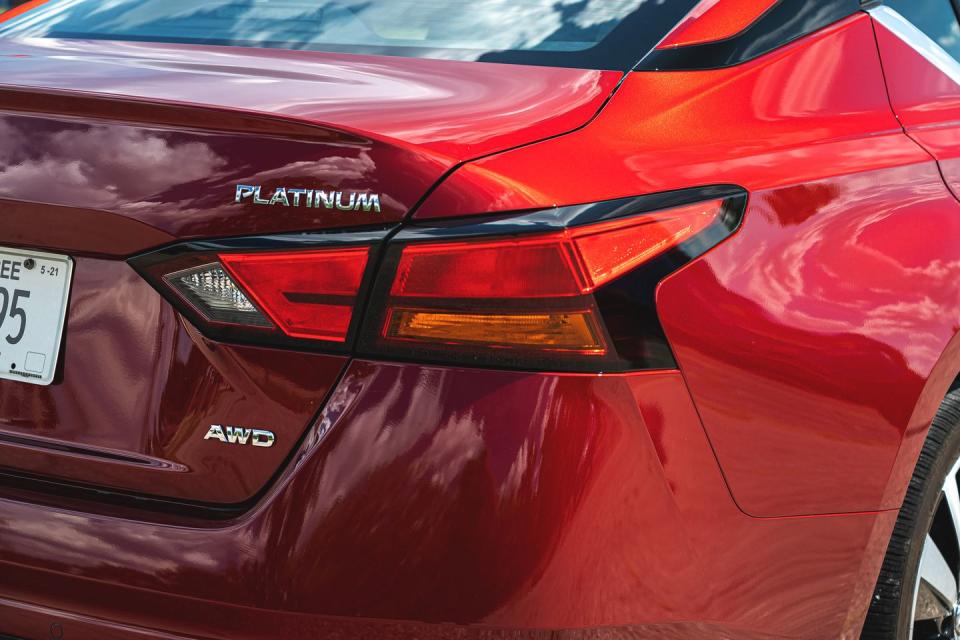
We said pretty much the same in our 20,000-mile update. Indeed, the 7587 miles we've put on the car since then have only confirmed that the Altima's pluses and minuses cancel each other out with mathematical precision. Everyone who gets behind the wheel agrees that its handling is reasonably adept, the cabin is roomy and decently appointed, the trunk accommodates big Costco runs with ease, and the front seats are comforting thrones. Based on those attributes, argues videographer and assistant photographer Brad Fick, "The Altima makes a solid argument for a family sedan."
But over and over again, the base powertrain negates this car's positives. We ordered the all-wheel-drive system because, at the time, neither of the Altima's big-selling family-car rivals—the Toyota Camry nor the Honda Accord—offered it, and we wanted to try it during a snowy Michigan winter. Toyota has since made all-wheel drive available on the Camry, and Kia will offer it on the 2021 K5. Nissan's system proved to operate seamlessly, but experience has taught us that a front-drive vehicle on good winter tires is a solid alternative to an all-wheel-drive car or SUV on all-season rubber. Full disclosure: We equip all our long-term vehicles with winter tires for the cold-weather months. For that reason, we'd forgo the $1350 all-wheel-drive system and instead put that cash toward the optional turbocharged engine.
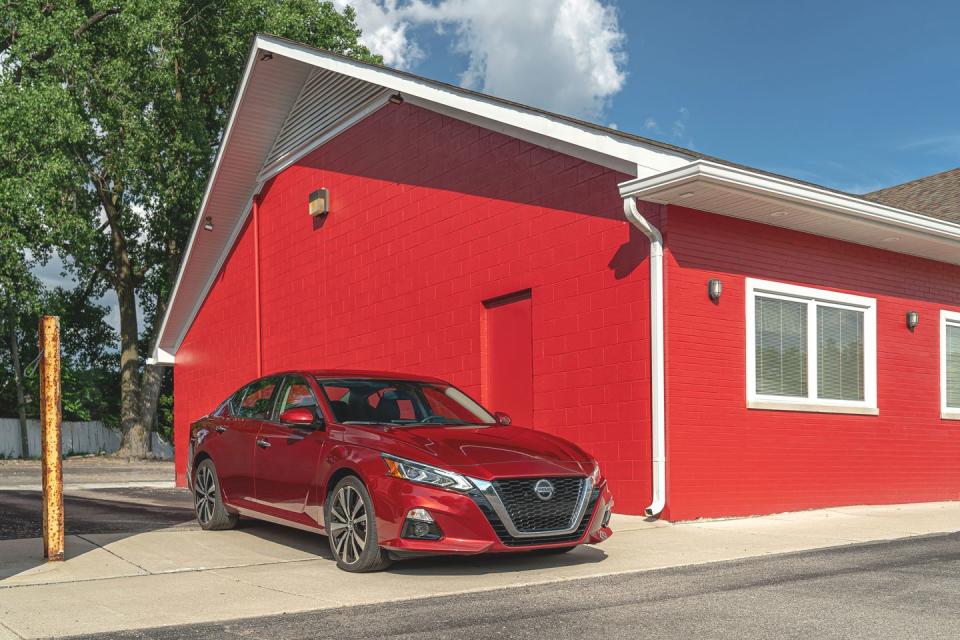
Since we last checked in, we've had zero unscheduled trips to the dealer, visiting once for a scheduled oil change, multipoint inspection, and tire rotation. It cost us $100.30. We do have two complaints about the Altima's core reliability, though—one minor and the other maddening. A persistent rattle drove photo assistant Charlie Ladd to inspect every inch of the rear end. He found a screw on the trunk floor that had backed out of the latch and fixed the problem himself. But the wonky audio-system volume knob is still driving us crazy; twisting the knob clockwise sometimes makes the music louder but other times makes it quieter. "This volume knob enrages me," said Mortimer. "Sometimes up means down and vice versa." We'll have this repaired during our next dealer visit to ward off further staff crabbiness.
Now that the Altima is three-quarters of the way through its 40,000-mile trial, it seems that our opinion of this car—at least with this particular powertrain—is stuck in neutral. "This car is totally unremarkable," said staff editor Annie White, "except for the fact that the volume knob is broken, which is really annoying." We'll see if anything transpires during the remainder of the Altima's time with us to jolt us out of our ennui.
Months in Fleet: 16 Current Mileage: 30,259
Average Fuel Economy: 28 mpg
Fuel Tank Size: 16.0 gal Observed Fuel Range: 448
Service: $100.30 Normal Wear: $0 Repair: $0
Damage and Destruction: $0
20,000-Mile Update
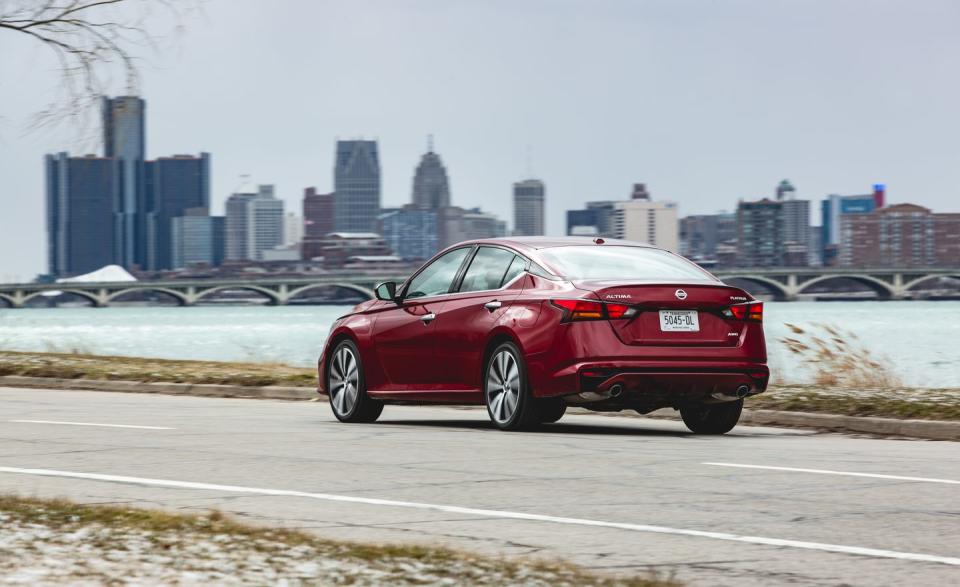
Our long-term Nissan Altima may be wholly capable as a family sedan, but a scenery-blurring, gut-compressing rocket it is not. Now, we'll cop to our bias for vehicles with wide-awake performance. But the Altima's lack of excitement is a shame, because its torpor just might be the reason why it's underappreciated and often overlooked for road-trip duty by our staff of heavy-footed drivers.
We've had the Altima for eleven months, during which time it has accumulated 22,672 miles. Some of our long-termers have racked up considerably more mileage over the same period. Our Nissan's test results tell the story of its lethargy. It accelerates to 60 mph in 7.6 seconds, which means even a Honda Odyssey minivan can show its taillights to our handsome metallic red sedan. Heck, even an 8260-pound diesel-powered GMC Sierra HD heavy-duty pickup leaves our Altima gasping.

"If you like wide-open throttle, don't buy this car," says deputy editor Tony Quiroga. "The surging and general rubber-band nonsense of the continuously variable automatic transmission (CVT) will ruin any joy." So, yes, we might have liked driving our Altima more if we had ordered it with the optional 248-hp turbo 2.0-liter inline-four, although that engine and its accompanying CVT haven't exactly impressed us in our long-term Infiniti QX50.
Why we didn't spec our test car with its more powerful engine is on us. We wanted to experience the Altima's optional all-wheel-drive system during our usually sloppy, cold Michigan winter. But all-wheel drive is only available with the base 182-hp 2.5-liter four that's under our car's hood. And wouldn't you know it, our current winter has been one of the warmest and least snowy in years.
There have, however, been a couple of significant snowfalls. The Altima has handled them effortlessly, thanks to our installation of a set of OE-size Nokian Hakkapeliitta R3 snow tires ($1285 for the four). "I drove the Altima from Detroit to Pittsburgh and back in one day, during a winter storm," videographer Brad Fick wrote in the Altima's logbook. "It was totally competent in those adverse conditions." And like almost everyone who has piloted the Altima, Fick praised its front seats for being both cushy and supportive. Aside from that 600-mile foray to Pennsylvania, the Altima also ventured to Dayton, Ohio. But mostly it has stayed close to our home base in southeastern Michigan as a day-to-day commuter.
Those who have spent time behind the Altima's wheel generally come away with positive thoughts. Thanks to responsive steering, a well-damped ride, and a firm brake pedal, this Nissan actually is engaging—once it lugs itself up to speed. "I always forget how good it is to drive, and I'm pleasantly surprised by the chassis," says senior editor Joey Capparella.
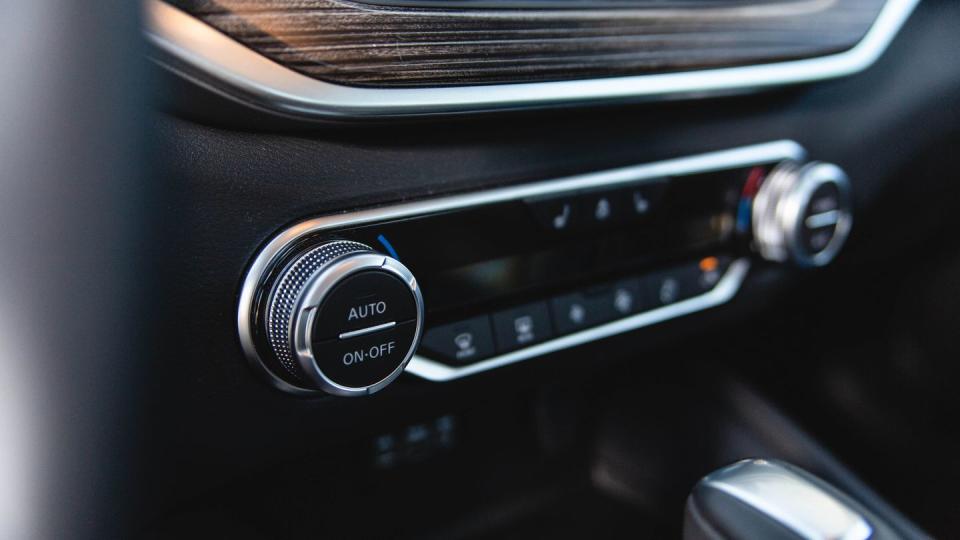
Long-term exposure to a car reveals its secrets, and this winter we've discovered a few things about our Altima that could be improved on. With more hours driving in darkness, we noticed that its auto-dimming inside rearview mirror doesn't filter out the glare of headlights enough for some of us.
The cold also brought up two interior-comfort issues. "The Altima's heated seats get only lukewarm," wrote senior editor Mike Sutton. "I also have to crank the heat much higher than in other vehicles to warm the cabin; setting the Nissan to 76 degrees feels like 72 in almost all other cars." We previously noted a similar problem during the summer, related to the car's overly effective air-conditioning system, which required us to bump the automatic temperature setting up to 78 degrees on a 71-degree day to keep the Altima's cabin from turning into an icebox. We're sure Nissan's engineers didn't design the automatic climate-control system to operate this way, and it otherwise works fine, so we'll have the dealer look into it at the next service.
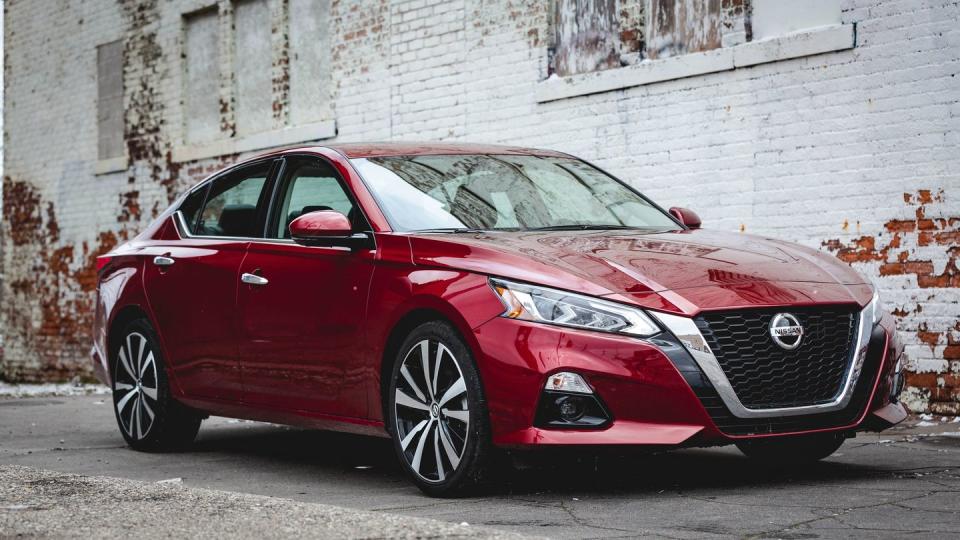
Speaking of service, the Altima has required virtually nothing beyond the routine kind. Its onboard service reminder displayed a message to bring the car in at 15,711 miles for scheduled maintenance, which included an oil and filter change, a new cabin air filter, and an update for the infotainment touchscreen's control unit. That set us back $113. Nissan recommends replacing the brake fluid at 20,000 miles, so we went back to the dealer for that plus a tire rotation, which together totaled $165. At 22,399 miles, it was time for another oil and filter change, which cost us a mere $22.
Unfortunately, that isn't all we've spent. We suffered a pair of financial hits due to damage. The first and by far the biggest is something that has become an issue for the entire auto industry: the cost of replacing a windshield. Today's windscreens are far more than large hunks of laminated safety glass. They are designed to enable the windshield-mounted sensors and cameras required by active-safety systems, such as adaptive cruise control and lane-keeping assist, to function properly. This makes windshields much more expensive than they used to be because a replacement requires recalibrating the sensors and cameras. When our Altima's windshield cracked, it cost $1103 to replace the glass and another $130 for the dealer to recalibrate the camera that looks through it.

Our pockmarked Michigan roads also damaged one of the Nissan's front tires, the second since we took delivery of the car. Our top-spec Altima Platinum runs low-profile 235/40R-19 Hankook Kinergy GT all-season tires. While their thin sidewalls look great, they apparently can't withstand the bite of a nasty pothole. Replacing that tire removed another $182 from our pockets.
Windshield-busting stones and tire-eating potholes aside, the Altima continues to serve us well. It's good-looking, comfortable, nimble, and, most important, reliable. It's just not that quick.
Months in Fleet: 11 months Current Mileage: 22,672 miles
Average Fuel Economy: 28 mpg
Fuel Tank Size: 16.0 gal Observed Fuel Range: 448 miles
Service: $362 Normal Wear: $0 Repair: $0
Damage and Destruction: $6076
10,000-Mile Update

We've now spent six months and 13,000 miles with Nissan's new-for-2019 Altima and have come to this almost-unanimous conclusion: It's likable. Pleasant. Competent. Nice. But is that a blessing or a curse?
That depends. If you're a serious car enthusiast, you'll appreciate and maybe even respect the new Altima's strengths—its chiseled good looks; its roomy, well-dressed interior; and its nimble handling. But we've found it just doesn't bring the heat.
Our long-term's 182-hp 2.5-liter inline-four is the culprit. We spec'd that engine rather than the optional 248-hp turbo four so we could also equip our car with all-wheel drive, which is only available with the base engine. The 2.5-liter masks its middling acceleration with sharp off-the-line throttle response, but when you ask for full power to merge or pass, it feels slower than it actually is. Exciting this version of the Altima will never be.
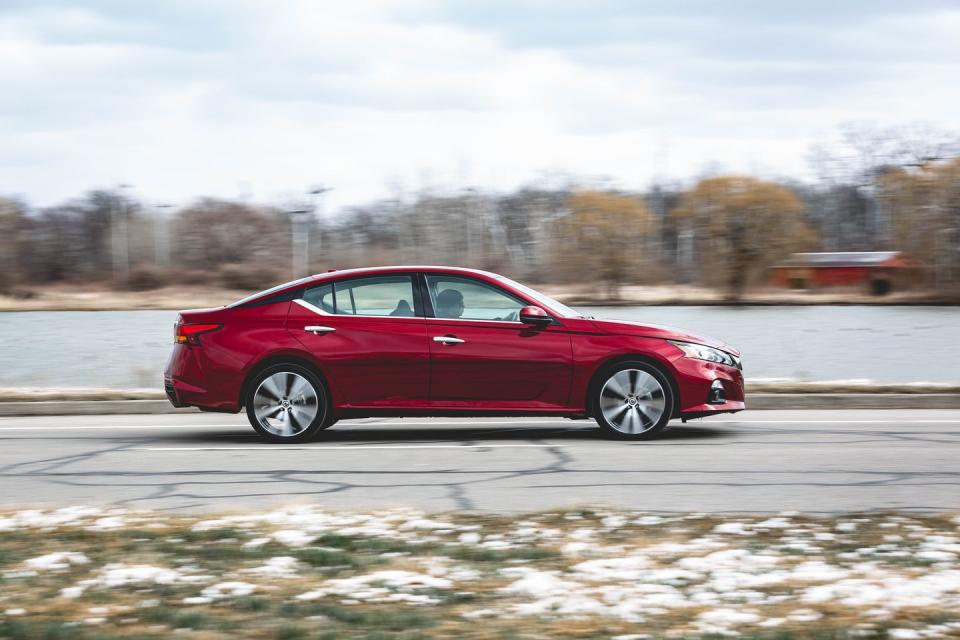
Then again, judging from our car's logbook comments, that's probably no issue for most of the family-car-buying public. Our Altima Platinum, the top model in the lineup, has revealed its pleasant character on drives long and short. It's trekked to Wisconsin, Chicago, and Mackinaw City—as far north as you can go in Michigan's Lower Peninsula. It's served as a workaday commuter and weekend errand runner and averaged an impressive 28 mpg to date.
"I think this chassis rivals the Accord's in terms of refinement and wheel control," noted staff editor Joey Capparella. "It's really pleasant to drive, even if it's not all that engaging." Indeed, the Altima felt as athletic as our long-term 2018 Honda Accord, which spent a short time in our fleet alongside the Nissan. But the Accord was equipped with its optional 252-hp turbocharged 2.0-liter inline-four, which made it feel like fighter jet in comparison with the Altima.

For longer drives, we found the Altima a low-stress place to be. It's quiet on the highway, and the ride is adequately supple. The front seats are extremely comfortable, with a plush layer of foam under their leather covering. Staff editor Drew Dorian wrote, "I quite like this car. It's handsome and drives nicely." There's that word again.
Not that the Altima's niceness extended to every aspect of its personality. The Intelligent Lane Intervention feature, which attempts to keep the car centered in its lane when the adaptive cruise control is engaged, is obnoxious. If the driver allows the car to drift just a little too close to a lane marker, the system stabs a front brake and causes the car to jerk back into line. It's as subtle as a smack upside the head. Luckily, the system can be turned off. The rear automated-braking system has a habit of jamming on the brakes as we back into our office parking spots, apparently mistaking the approaching curb for a much taller object.

"Rear visibility is awful, due to the high rear decklid," reported staff editor Annie White. Nor is the Bose sound system up to that firm's normal standards. "The audio system is too bass heavy," noted staff editor Alex Stoklosa. "The operative description is 'muddy,' and fiddling with the equalizer doesn't help." And on our Wisconsin expedition, we found that the nav system's map was sometimes no help at all. Entire towns were missing, and at one point, we were on a two-lane road in the Cheesehead state that the map said didn't exist.
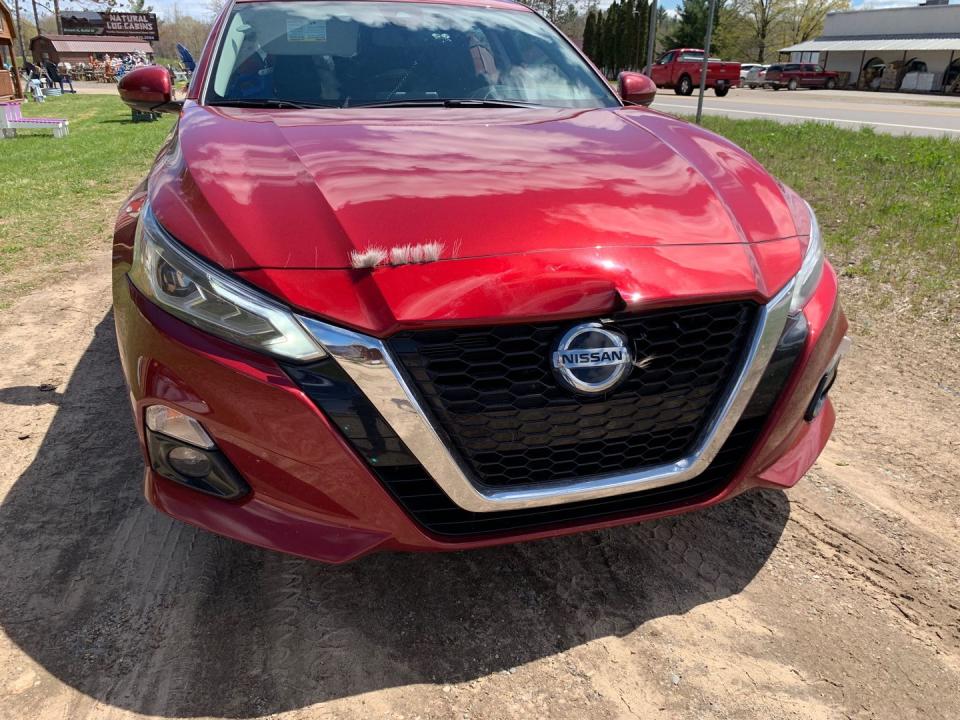
More important, though, is that the Altima has proved dead reliable. We've had only one minor service, which the onboard diagnostic system asked for at the 8300-mile mark. It cost $62. The only significant problem we've encountered was one of Mother Nature's making: production designer Jeff Xu had an unfortunate meeting with a deer near Michigan's picturesque Sleeping Bear Dunes National Lakeshore. While the accident appeared to put little more than a small tear in the front bumper cover, the unseen damage to a sensor and the right headlight ran up the repair cost to a jaw-dropping $4479.

Beyond that it's been easy sailing—emphasis on "easy." The Altima makes a virtue of being inoffensive. "Nothing really stands out about this car, and that's why I like it," wrote Capparella. White underscored that by adding, "I took this car to Chicago a while ago, and it was so unremarkable that I forgot to take notes. Unremarkable is not always bad, though." In fact, we think that's just what this car's target audience is seeking.
Months in Fleet: 6 Current Mileage: 13,021 miles
Average Fuel Economy: 28 mpg
Fuel Tank Size: 16.0 gal Observed Fuel Range: 440 miles
Service: $62 Normal Wear: $0 Repair: $0
Damage and Destruction: $4479
Introduction
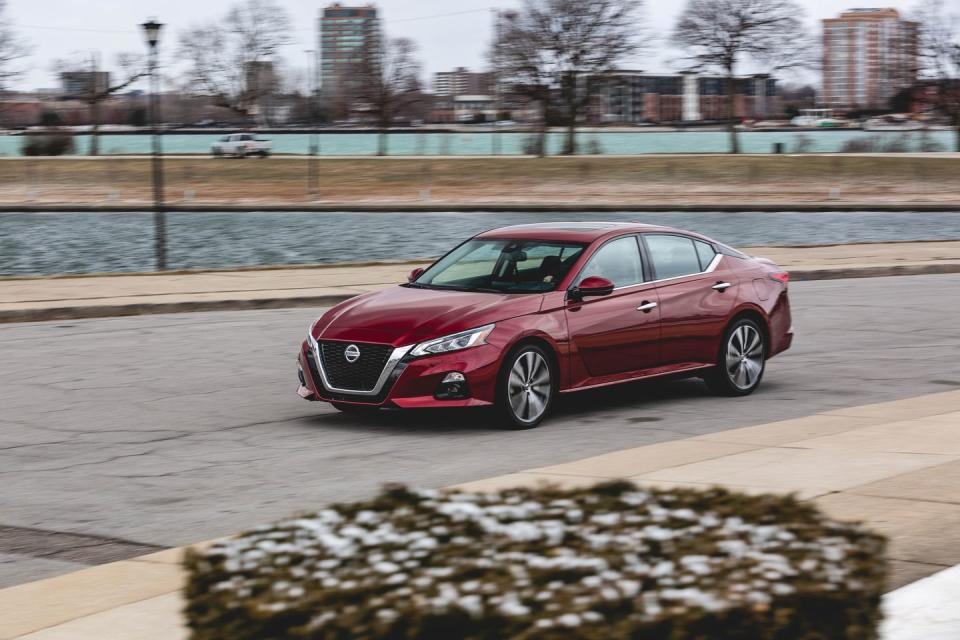
The sedan is dead, or so it has been written. In 2018, about 70 percent of all new vehicles sold in the United States were anything but passenger cars—SUVs, crossovers, pickup trucks, and for all we know, flying saucers. And yet, in the midst of this buyer exodus from low-to-the-ground vehicles, the mid-size family sedan lives on: Americans bought 1.5 million of them in 2018, and the three biggest players—the Honda Accord, the Nissan Altima, and the Toyota Camry—accounted for more than 50 percent of that total.
Those three aren't half-hearted efforts, either; the Accord punched its way onto our 2019 10Best Cars list for the 33rd time, and both the Camry and the new-for-2019 Altima earned Editors' Choice awards. That's one reason we've welcomed the Nissan into our long-term fleet. Another is that we can gauge just how good it is on a daily basis against the gold-standard Accord, one of which is also racking up miles in our long-term lineup.

This new Nissan had us at first drive. It kept the good from the last generation—low mass, decent fuel economy, and a roomy interior—and left many of the negatives behind. Sleek, crisply folded sheetmetal replaces the old car's anonymous, softly rounded lines, which made it look as if it were slouching and wanted to avoid being driven. Given the old car's uninvolving road manners and sleepy performance, its appearance did not set up any false expectations. The new model looks, well, almost sexy. Did we just say that about an Altima? Its interior has been spruced up significantly and modernized with nicer materials and a good-looking infotainment system. The suspension has enough sinew now to actually make driving interesting. And the Altima offers one powertrain option that neither of its competitors from Honda and Toyota can boast of: all-wheel drive. Given our location in the heart of the country's snow-and-ice belt, we wanted to take advantage of the added winter traction that all-wheel drive affords.
Altimas can be powered by either of two engines, both of which couple with a standard continuously variable automatic transmission (CVT): a 182-hp naturally aspirated 2.5-liter inline-four carried over from the previous Altima, and the company's new but complex 248-hp turbocharged 2.0-liter four, known as VC-Turbo, which employs Nissan's variable compression system. We already have an Infiniti QX50 fitted with that engine in our long-term test fleet, and its rubber-band-like throttle response and throbbing engine note have not endeared it to us. So we played against type and didn't opt for the more powerful engine in the Altima, choosing instead to equip our test vehicle with the base 2.5-liter—which was doubly convenient because the AWD system is available only with the less powerful engine.

We knew from previous drives that the base engine would deliver a more refined—if significantly less exciting—driving experience. Our initial track test confirmed that it is definitely not going to set anyone's hair on fire with its straight-line performance, but it should be adequate for most family-sedan buyers. After doing our best to respect the 1200-mile break-in period, we took the Nissan to the track, where it jogged to 60 mph in 7.6 seconds and through the quarter-mile in 15.8 seconds at 90 mph. A Honda Odyssey minivan will outdrag it to 60 mph by a full second—our long-term Accord smokes it by two—but the Altima acquits itself well elsewhere.
Unlike the optional variable-compression engine, the 2.5-liter's response to your throttle foot is smooth and linear, and the CVT is well-behaved, almost never letting the engine drone for long when merging onto the interstate or slicing through traffic. The Altima also managed a quite respectable 0.93 g on the skidpad and a 170-foot stop from 70 mph. And it feels good doing it. The Altima's reflexes are sharper than the family-sedan norm on back roads, its ride is firmly sporting, and it lopes along comfortably on the highway. Speaking of highway cruising, you'll need a rest stop long before the Altima needs to hit a gas station. A near-identical Altima returned a stellar 41 mpg on our 200-mile highway fuel-economy test last fall, outdoing its 36-mpg EPA highway estimate by a healthy 14 percent. That suggests we might one day travel well beyond 600 miles on a tank during a long interstate road trip.

That base engine aside, our Platinum test car is a top-shelf pour. The list of standard equipment is comprehensive and includes a power sunroof, leather seating, heated front seats and steering wheel, and power-adjustable front buckets. An 8.0-inch touchscreen occupies the center stack and enables access to navigation, the dual-zone climate control, and a Bose nine-speaker sound system with volume and tuning knobs and satellite radio. Apple CarPlay and Android Auto functionalities are standard, and there are four USB ports to support your personal tech.
The Platinum also comes standard with a plethora of Nissan active-safety gear, from automated emergency braking with pedestrian detection to rear automatic braking. The ProPilot Assist system adds adaptive cruise control with full-stop capability and steering assist, which works to keep the car centered in the lane. There's also lane-departure warning, rear cross-traffic alert, and lots more. We'll let you know if it's even possible to get into trouble with all of these driving aids on duty and whether they're a nuisance or a blessing.

We'll also see how the Altima fares against its primary foe, the perennially award-winning Accord—considering that the two apples in this taste-off are as different as a Gala and a Granny Smith. That's because we went in different directions when ordering their powertrains: The Honda is equipped with the line's top-spec mill, a tire-smoking, 252-hp turbocharged 2.0-liter inline-four, which is mated to a 10-speed automatic and powers only the front wheels. Still, these sedans are more alike than different: Both are metallic red with prices that hover around $35,000. Both are intended to handle the everyday duties of a family sedan. Both are loaded. Both are aimed at the same customer. Is the challenger closing in on the champ? We'll roll up the miles in the new Altima and let you know what we find along the way.
Months in Fleet: 1 month Current Mileage: 1776 miles
Average Fuel Economy: 25 mpg
Fuel-Tank Size: 16.0 gal Observed Fuel Range: 400 miles
Service: $0 Normal Wear: $0 Repair: $0
Damage and Destruction: $0
You Might Also Like


